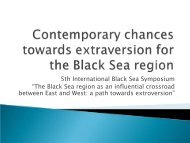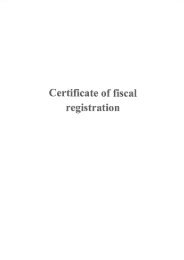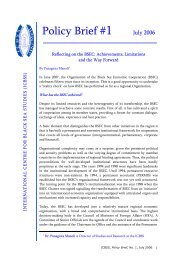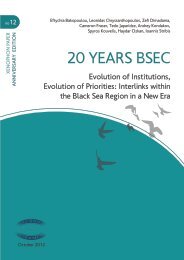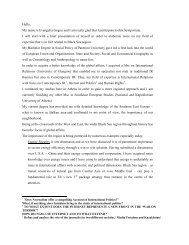Xenophon Paper 2 pdf - ICBSS
Xenophon Paper 2 pdf - ICBSS
Xenophon Paper 2 pdf - ICBSS
You also want an ePaper? Increase the reach of your titles
YUMPU automatically turns print PDFs into web optimized ePapers that Google loves.
Between optimism and pessimism: Armenia’s coherent, but non-pursued objectives<br />
Turkey’s recognition of Armenia’s independence in 1991, the opening of the Armenian-<br />
Turkish border on the one hand, and the traditional solidarity and friendship with Georgia<br />
along with the common goal of immediate liberation from the Soviet Empire on the other<br />
hand, brought about hopes in Armenia that the Black Sea bridge connecting the country<br />
to Europe would function permanently and that collaboration would reach maximum<br />
capacity. The objectives and principles set out in the founding documents (e.g. the<br />
Istanbul Declaration and Bosphorus Statement—of the Istanbul Summit on Black Sea<br />
Economic Cooperation (BSEC) signed on 25 June 1992, by the heads of states and<br />
governments of 11 countries—Armenia, Albania, Azerbaijan, Bulgaria, Georgia, Greece,<br />
Moldova, Romania, Russia, Turkey and Ukraine) brought optimism concerning Armenia’s<br />
pursued objectives. The BSEC was seen as an attempt to institutionalise the region<br />
bridging Europe and Asia.<br />
Specifically in the Istanbul Declaration and the Bosphorus Statement, the signing countries<br />
were “taking into account the profound and rapid changes in Europe and the determination<br />
of the peoples of the continent to shape a new era of peace and security on the basis<br />
of the principles laid down in the Helsinki Final Act and follow up CSCE documents,<br />
particularly in the Charter of Paris for a new Europe”. 3 The second point in the Declaration<br />
recognised “that a prosperous and united Europe will evolve on shared values such as<br />
democracy based on human rights and fundamental freedoms, prosperity through<br />
economic liberty and social justice, and equal security for all countries”. Subsequently,<br />
all countries – including Armenia – which had launched the Black Sea Economic<br />
Cooperation were, on the one hand, anticipating the expansion of New Europe and the<br />
dissemination of its value system toward this region, and “taking into consideration the<br />
potential of the Participating States and the opportunities for enhancing the mutually<br />
advantageous economic cooperation arising from their geographic proximity and from<br />
the reform process and structural adjustments” on the other.<br />
The 25 June 1992, Bosphorus Statement stated that, “With a shared vision of the future<br />
and through mutual cooperation, the Heads of State and Government looked forward<br />
to the transformation of the Black Sea into a region of peace, freedom, stability and<br />
prosperity. They stressed that in the building of the new architecture of Europe, their<br />
countries and peoples had an important and creative contribution to make and that the<br />
Black Sea Economic Cooperation constituted an effort that would facilitate the processes<br />
and structures of European integration”.<br />
3 BSEC (1992), ‘Summit Declaration on Black Sea Economic Cooperation’, Istanbul, 25 June.<br />
14 UNFOLDING THE BLACK SEA ECONOMIC COOPERATION VIEWS FROM THE REGION



